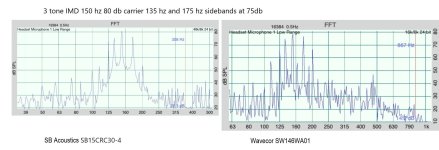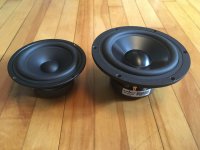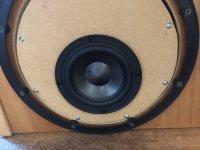Another IMD (Intermodulation Distortion) test. The first in the 5" driver size. I will be comparing the Sb Acoustics SB15CRC30-4 with the Wavecor SW146WA01, these measurements have been made under the same conditions as my other tests done in 14 liters such as the slighter larger 6-7" tests https://www.diyaudio.com/community/...ootout-purifi-anarchy-plus-maybe-more.371979/
The Sb Acoustics SB15CRC surprised me with how crystal clear the midrange is, this showed up in measurements and in listening tests. The Sb had one of the cleanest three tone tests at 800 hz of 20 drivers (only surpassed by a 8" Purifi, but out performing a Magico midrange). With music, I noted in songs that had duets that you could pick out the singers individually as opposed to a kind of a combined vocal that comes out of most drivers.
The Wavecor SW146 also did very well in some of the tests especially the 60 and 144hz bass IMD test. The Wavecor has a low loss suspension and will give a good punch to a kick drum. However, having tested the very slightly larger SW182 (see size comparison in attached photo) I do prefer that one for cleaner deep bass output.
Testing conditions are as follows: The test enclosure is a .5 cu ft (14 liter) sealed box with the bottom lip of the speaker just 2 inches above the floor. The microphone is on a stand 49"high with the base of the microphone 33" from the driver. A distance of about 1.5m from the speaker to the microphone. As I'm not measuring in an anechoic chamber my measurements are not comparable to anyone else's but comparisons can be made between the drivers I test.
For information about how to read the graphs see here: https://www.facebook.com/.../posts/1938870303135464/...
As always, I'm open to feedback and driver testing suggestions.
The Sb Acoustics SB15CRC surprised me with how crystal clear the midrange is, this showed up in measurements and in listening tests. The Sb had one of the cleanest three tone tests at 800 hz of 20 drivers (only surpassed by a 8" Purifi, but out performing a Magico midrange). With music, I noted in songs that had duets that you could pick out the singers individually as opposed to a kind of a combined vocal that comes out of most drivers.
The Wavecor SW146 also did very well in some of the tests especially the 60 and 144hz bass IMD test. The Wavecor has a low loss suspension and will give a good punch to a kick drum. However, having tested the very slightly larger SW182 (see size comparison in attached photo) I do prefer that one for cleaner deep bass output.
Testing conditions are as follows: The test enclosure is a .5 cu ft (14 liter) sealed box with the bottom lip of the speaker just 2 inches above the floor. The microphone is on a stand 49"high with the base of the microphone 33" from the driver. A distance of about 1.5m from the speaker to the microphone. As I'm not measuring in an anechoic chamber my measurements are not comparable to anyone else's but comparisons can be made between the drivers I test.
For information about how to read the graphs see here: https://www.facebook.com/.../posts/1938870303135464/...
As always, I'm open to feedback and driver testing suggestions.
Attachments
-
 3IMD150hz70dbSvW.jpg147.9 KB · Views: 209
3IMD150hz70dbSvW.jpg147.9 KB · Views: 209 -
 3IMD150hz80dbSvW.jpg176.4 KB · Views: 182
3IMD150hz80dbSvW.jpg176.4 KB · Views: 182 -
 3IMD300hz70dbSvW.jpg143.5 KB · Views: 174
3IMD300hz70dbSvW.jpg143.5 KB · Views: 174 -
 3IMD300hz80dbSvW.jpg143.4 KB · Views: 167
3IMD300hz80dbSvW.jpg143.4 KB · Views: 167 -
 3IMD300hz90dbSvW.jpg148.7 KB · Views: 165
3IMD300hz90dbSvW.jpg148.7 KB · Views: 165 -
 3IMD800hz80dbSvW.jpg137.9 KB · Views: 154
3IMD800hz80dbSvW.jpg137.9 KB · Views: 154 -
 3IMD800hz90dbSvP.jpg152.3 KB · Views: 154
3IMD800hz90dbSvP.jpg152.3 KB · Views: 154 -
 IMD40hz70dbSvW.jpg176.3 KB · Views: 136
IMD40hz70dbSvW.jpg176.3 KB · Views: 136 -
 IMD60hz80dbSvW.jpg130.5 KB · Views: 130
IMD60hz80dbSvW.jpg130.5 KB · Views: 130 -
 IMD60hz90dbSvW.jpg153 KB · Views: 132
IMD60hz90dbSvW.jpg153 KB · Views: 132 -
 IMD75hz80dbSvW.jpg141.9 KB · Views: 184
IMD75hz80dbSvW.jpg141.9 KB · Views: 184 -
 IMG_5189.JPG320.6 KB · Views: 173
IMG_5189.JPG320.6 KB · Views: 173 -
 IMG_5458.JPG338.8 KB · Views: 199
IMG_5458.JPG338.8 KB · Views: 199
One aspect to consider is that your may need to adjust for the same SPL for all the drivers. Also, you might want to go nearer as anything rattling will add to distorsion. I would go so far that it would be ideal if your could EQ the drivers to say within 1 dB (between them) and then the SPL to 1/2 dB. Then, and only then can a true comparison be done.
Why - because if a certain driver has e.g, a peak at say 3khz and and the other a dip of 3 dB at the same frequency, a 6 dB difference is present - it will be enough to make glass or metal boxes rattle - this could equate almost double the distortion...
I realised this as I was trying to measure if a resistor in series or a resistor and an inductor would make any change to distortion... how the FR was affected by these passive components skewed the results so they became not immediacy comparable - I simply had to do compensation to make a proper judgment... post...
The first attachment (3 tone), are you sure the background noise was the same for the two occasions... really big difference in the "grass"... for IMD, the background noise is really important - much more so than for a sweep....
Just a few ideas I had as I read this very interesting test as I'm currently after a 5" driver for an upcoming project.
I wish the SB NBAC was on the start line... 🙂
Thanks for the information!
//
Why - because if a certain driver has e.g, a peak at say 3khz and and the other a dip of 3 dB at the same frequency, a 6 dB difference is present - it will be enough to make glass or metal boxes rattle - this could equate almost double the distortion...
I realised this as I was trying to measure if a resistor in series or a resistor and an inductor would make any change to distortion... how the FR was affected by these passive components skewed the results so they became not immediacy comparable - I simply had to do compensation to make a proper judgment... post...
The first attachment (3 tone), are you sure the background noise was the same for the two occasions... really big difference in the "grass"... for IMD, the background noise is really important - much more so than for a sweep....
Just a few ideas I had as I read this very interesting test as I'm currently after a 5" driver for an upcoming project.
I wish the SB NBAC was on the start line... 🙂
Thanks for the information!
//
Last edited:
Thanks for the feedback TNT. I do EQ all the tones as well as I can. This is done in real time so I try to be quick about as to not let the voice coil heat up. What's also interesting is how some drivers show compression of the tones. For example, all tones are matched at 70db and by the time I get to 90db, with some drivers one of the tones is down a db or two. I try to compensate for this. The worst offender I've seen for this was the Epique 180.
I always do a little research to determine what would be interesting to test and found this test which showed the CRC to have lower IMD than the NBAC.
https://www.justdiyit.com/sb17nbac35-4-versus-sb17crc35-4-le-duel-fratricide/
I do see some fluctuation of the noise floor as you noted, I personally put more value on the drivers that are doing better in my higher spl tests for this reason.
I always do a little research to determine what would be interesting to test and found this test which showed the CRC to have lower IMD than the NBAC.
https://www.justdiyit.com/sb17nbac35-4-versus-sb17crc35-4-le-duel-fratricide/
I do see some fluctuation of the noise floor as you noted, I personally put more value on the drivers that are doing better in my higher spl tests for this reason.
Last edited:
| Measuring conditions, harmonic distortion Driver mounting: In sealed enclosure, internal volume 5 lit., Microphone distance: 0.5 m Input signal: Stepped sine wave, 6.2 VRMS (WF182BD13/15) / 8.0 VRMS (WF182BD14/16) Smoothing: 1/12 oct. |
| Notes | Parameter | WF182BD13/15 | WF182BD14/16 | Unit |
| Sensitivity, 2.83V/1m (average SPL in range 300 - 1,000 Hz) | 91 | 88 | [dB] |
So that is not exactly low level distortion 😉
https://audioxpress.com/article/voice-coil-test-bench-wavecor-s-wf182bd13-04-7-midbass-driver
Yet, in Voice Coli mag, every single product test ends up in glorious praise... also this one... "...WF182BD13 looks like an excellent addition to Wavecor’s lineup...
//
//
Hi,
I it's interesting to see some testing. However, to really get the idea what's going on we need to test IMD at worst-case scenario frequencies. Very often, HD and IMD have same/similar underlying non-linearity causes arising due to driver's motor design and this often manifests as elevated 3rd harmonic. Therefore, at frequencies where harmonic distortion is high we can expect to see elevated IMD as well. So, first do HD sweep to find peaks for HD. Then, run IMD test at high harmonic distortion positions, in realistic range of use with high frequency ratio, eg 70:2000Hz or so. Would be interesting to see the result.
Regards
I it's interesting to see some testing. However, to really get the idea what's going on we need to test IMD at worst-case scenario frequencies. Very often, HD and IMD have same/similar underlying non-linearity causes arising due to driver's motor design and this often manifests as elevated 3rd harmonic. Therefore, at frequencies where harmonic distortion is high we can expect to see elevated IMD as well. So, first do HD sweep to find peaks for HD. Then, run IMD test at high harmonic distortion positions, in realistic range of use with high frequency ratio, eg 70:2000Hz or so. Would be interesting to see the result.
Regards
That is actually even necessary to be able to compare apples with apples.One aspect to consider is that your may need to adjust for the same SPL for all the drivers
Or in other words, to have any meaningful results at all.
It would be far more interesting to see IMD tests with a lower frequency plus mid range frequency.
I think those wonderful SB Acoustics woofers wouldn't be as nice anymore, since their Kms(x) isn't particularly linear.
In that case we'll only end up in yet another can of worms, since we have to make sure the total system response is equal between all samples.
Which brings up the question.
What is a good and fair system response to tests these things? 🤔
My take on system response is in post #2. Yes it's tight but with DSP it should be doable after a few rounds.
//
//
Which Magico driver did you have on hand?but out performing a Magico midrange
Taken out of a Magico S5.
https://www.diyaudio.com/community/...i-anarchy-plus-maybe-more.371979/post-7646728
https://www.diyaudio.com/community/...i-anarchy-plus-maybe-more.371979/post-7646728
Thanks for the feedback guys. I consider my bass IMD tests to be sort of a torture test because the low tone creates excursion and the high tone is usually around the impedance minima where current is high. But it would be interesting to cover the whole range of the midwoofer like 40-2000 hz, this could test how clean drivers are with excursion and as they get close to breakup. Drivers tend to be cleanest when run at their impedence peak so really the more variety of frequency tests the better to even out the favorable and non favorable frequencies.
Piotr z, should I instead look into the WF152BD09? This is more similar in size to the SB CRC15, but I've also done quite a few 7" drivers that I could compare the WF182BD13 to.
Piotr z, should I instead look into the WF152BD09? This is more similar in size to the SB CRC15, but I've also done quite a few 7" drivers that I could compare the WF182BD13 to.
It was hidden but you meant the "post" link lolMy take on system response is in post #2. Yes it's tight but with DSP it should be doable after a few rounds.
//
In this case I personally would pick two lower frequencies, say 60Hz and 100Hz or so.
For the 2nd frequency pick something in the full mid range where the ear is the most sensitive.
So I guess 500Hz, 1kHz and 2.5kHz
This will result in six measurements all together.
Obviously all with the exact same system response.
I guess we can do the same when a couple of these midwoofers are being used from 100Hz and up.
So pick 200Hz and 350Hz or something.
Although, in that case there is (very) little cone excursion.
- Home
- Loudspeakers
- Multi-Way
- 5" Intermodulation Distortion Testing